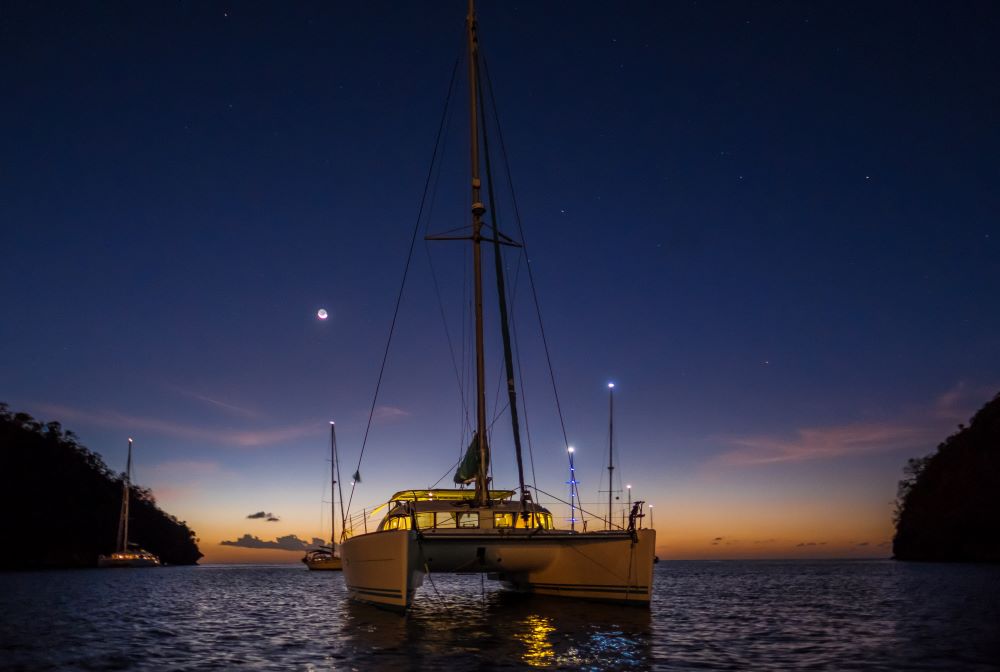
How to Anchor a Boat: Canadian Rules and Requirements
Anchoring a boat may seem like a fairly simple concept, but there are several factors that must be taken into account. Anchoring must be done safely so that the boat doesn’t drift or capsize. There are also regulations set forth by the Canadian government regarding acceptable anchorage locations and navigation lights.
Read on for a comprehensive guide to anchoring a boat safely and legally in Canada!
When to anchor a boat
Before we get into the procedure for anchoring a boat, it’s important to understand the situations when a boat should be anchored.
Generally, vessels and pleasure crafts use anchorage areas in the following circumstances:
- When waiting for permission to enter a port
- When waiting for a berth or cargo to become available
- For safety and security reasons
- In difficult weather conditions or low visibility
- During maintenance (when preparing the hold for cargo, making repairs or changing crew)
How long a boat stays at anchor can vary from a few hours to a few weeks depending on its reason for being anchored.
Anchoring regulations
In Canada, vessels at anchor are regulated by the Canada Shipping Act, 2001. Transport Canada enforces these regulations to limit the risk of accidents at anchor and make sure marine traffic flows smoothly.
Here are a few important aspects of anchoring regulations for vessels and pleasure crafts.
Where to anchor
It is the captain’s responsibility to make sure the vessel stays safe, and that includes choosing a safe anchorage. Anchorage may be prohibited in some areas for safety reasons (due to the presence of submerged cables or pipes, for example) or to protect marine ecosystems. Otherwise, boats are generally free to anchor temporarily almost anywhere it is safe to do so. The right to anchor a vessel is part of the common law right of navigation. For longer-term use, there are anchorages that require payment or authorization.
For example, when a vessel enters a Canadian port, the Port Authority tells the captain where they can anchor and for how long. The decision is based on factors such as:
- The depth of the water
- The proximity of environmental dangers such as sandbanks or rocks
- Tidal considerations such as strength, direction, and rising or ebbing
- Shelter from strong winds
- The distance between vessels
- The length and draft of the vessel
- The reason for anchoring
- The length of the vessel’s anchoring line
- The anchor’s hold on the sea floor
- The location of shipping routes
- Port logistics
- The proximity of landing points
Visibility of boats at anchor overnight
Boats that are anchored overnight must remain visible. The operator of a pleasure craft under 50 metres in length must display an all-around white light while at anchor overnight or in low visibility. When anchored in daylight, they should display a black ball.
A vessel under 7 metres in length that is at anchor overnight is not required to display a navigation light or device unless it is anchored in a narrow channel, a fairway often used by other vessels, or an anchorage near such places.
Anchor equipment
The equipment used to anchor a boat can include several components:
- Anchor
- Chain
- Anchoring line
- Rope to extend the chain
The length of chain, cable or rope that connects the anchor to the boat is called a rode. Large ships generally have two anchor rodes stored on board in a compartment called a chain locker.
How to anchor a boat correctly
- Attach one end of the rode to the boat and the other to the anchor.
- Slowly lower the anchor over the bow of the boat until it touches the bottom. Don’t drop the anchor over the side of the boat or attach it to the stern. Otherwise, the wind or current could cause the boat to capsize.
- Let out enough anchoring line to equal 5 to 10 times the depth of the water. This provides enough slack for the anchor to lay flat on the bottom of the waterway. Then, let the boat drift or use reverse thrust to help the anchor dig in. If the anchoring line is only 2 to 4 times the depth of the water, the upward pull will be too strong for the anchor to get a proper hold.
- Once the anchor is in place, choose at least two fixed landmarks on the horizon or shore and use them to check the boat’s position frequently and make sure it isn’t drifting.
- When it’s time to leave, reel in all of the extra anchoring line and haul the anchor back into the boat.
Master boating with the NBSS!
There’s no need to be afraid of anchoring your boat. With an understanding of the proper procedure and good technique, anyone can do it. Just keep the safety and legal considerations in mind!
In order to legally operate a boat in Canadian waters, you need to have your pleasure craft operator card on you at all times. So, register for our boater safety course today if you haven’t already!
If you’re looking for more tips on boating safety or basic maneuvers, the National Boating Safety School is a great resource. Our boating license study guide is a useful tool for new boaters and those who want to review before taking their boating exam online.

